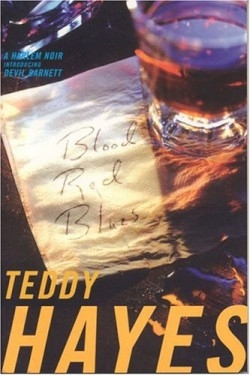Blood Red Blues
After the murder of his father, Devil Barnett, a field agent for the CIA, returns home to Harlem to take over his father’s bar, the Be-Bop Tavern. Not long after, somebody slaughters a group of people in the back room of another tavern, the Tease Me Club. That room had been used as a brothel, and one of the victims was a Japanese diplomat. Deke Robinson, a former FBI agent turned state legislator, asks Barnett to look into the crime. When Barnett, who despises Robinson, declines, Robinson applies political pressure on a family member and Barnett reluctantly agrees to conduct an unofficial investigation.
Barnett then travels the seamier dark alleys of Harlem, talking to two-bit hustlers, drug dealers, hookers, and crime lords, trying to find the identity of a hooker named Peter Pan, believed to be involved in the killings. Before his investigation gets far, some Korean businessmen are murdered, apparently by the same assassin. Relying on information supplied by a former partner still with the CIA, and teamed with a Harlem cop, Devil starts shaking the bushes, ready for any vermin that might come out. His techniques range from bribery to manipulation to blackmail.
This is the first of several Devil Barnett novels that the author has written. He has also written and produced stage plays and material for American network television. Born in Cleveland, Ohio, he moved to London, England, where he continues the Barnett series, writes and directs films, and owns a music production company that focuses on jazz and rhythm-and-blues music like that described in Blood Red Blues.
As the plot of this novel grows more complicated, so does Devil Barnett’s life. The story cuts back and forth between the assassin and his lover and Devil’s world, including his Uncle Bean, a sort of low-level black Harlem mobster, who has an intricate romantic life.
This book takes place within a wonderful atmosphere, pulsing with Harlem nightlife and a soundtrack of jazz and blues. Devil Barnett is an engaging character, though his background seems a little improbable. Still, he’s entertaining and believable. Hayes has entered Walter Mosley territory here, though his Harlem sometimes has an older, rather than contemporary, feel. Without the computers and cell phones, the author’s Harlem could just as well belong in the 1950s, ’60s or ’70s. At its best, Blood Red Blues sings with a strong sense of pace, an appealing authorial voice and imaginative, evocative prose. (September)
Mark Terry
Reviewed by
Mark Terry
Disclosure: This article is not an endorsement, but a review. The publisher of this book provided free copies of the book to have their book reviewed by a professional reviewer. No fee was paid by the publisher for this review. Foreword Reviews only recommends books that we love. Foreword Magazine, Inc. is disclosing this in accordance with the Federal Trade Commission’s 16 CFR, Part 255.

